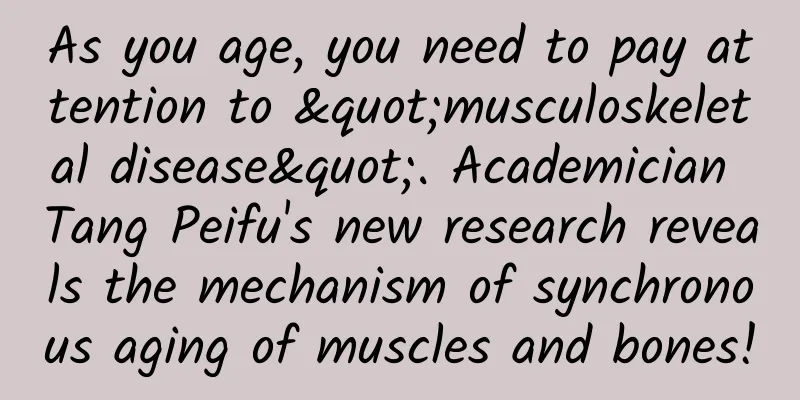Beware of Osteoporosis That Occurs Silently

|
This is the 4079th article of Da Yi Xiao Hu 1. What is osteoporosis? Osteoporosis is a systemic bone disease caused by a decrease in bone density and bone quality, destruction of bone microstructure, and decreased bone density and strength, increased bone brittleness, and easy fractures. In my country, the prevalence of osteoporosis in women over 50 years old is 32.1%, and in men it is 6.0%; in people over 65 years old, the prevalence of osteoporosis in women is 51.6%, and in men it is 10.7%. Since osteoporosis usually has no obvious symptoms in the early stages and occurs quietly, many elderly people have osteoporotic fractures before they attract attention. Fractures in the elderly over 70 years old affect their life expectancy even more. Osteoporosis increases the risk of premature death in the elderly to a certain extent. 2. Why does osteoporosis occur? Many young people think that osteoporosis is an old age disease and has nothing to do with them. In fact, bones are constantly changing throughout a person's life. During childhood, bones grow, and osteoblasts in cartilage collect and store minerals such as calcium to form hard compact bone and fluffy spongy bone inside. In order to replace the bones of the fetal period, osteoclasts come on stage, and they work with osteoblasts to "remove the old and rebuild" to keep the bones growing. During adolescence, the activity of osteoblasts doubles, and the human body grows rapidly. In early adulthood, the activity of osteoblasts decreases, and bone mass accumulates slowly. At the age of 30, the human body's bone mass reaches its peak, while osteoclasts are still vigorous, and the body's spongy bone is lost at a rate of 0.5% to 1% per year. After the age of 50, especially for women, estrogen levels drop sharply after menopause, and bone mass is lost faster. Osteoblasts cannot keep up with the "removal of the old" speed of osteoclasts, and the bone loss rate is greatly increased, leading to osteoporosis. Our bone mass is like the battery of a mobile phone. Before the age of 30 is actually a good time for us to recharge. A full battery can last longer. So when you are young, you should pay attention to accumulating bone mass, and when you are older, you should reduce bone loss. 3.How to prevent osteoporosis? 1) Nutrient supplements Calcium : According to the 2013 edition of the Chinese Dietary Reference Intake, the recommended daily calcium intake for adults is 800 mg (elemental calcium), and the recommended daily calcium intake for people aged 50 and above is 1000-1200 mg. Vitamin D : For people under 65 years old, the recommended intake is 400 U/d; for people 65 years old and above, the recommended intake is 600 U/d; for pregnant and lactating women, the recommended intake is 400 U/d. When vitamin D is used to prevent and treat osteoporosis, the dosage can be 800 to 1200 U/d. 2) Dietary supplements In daily diet, we must ensure adequate nutrition supply. Studies have found that calcium from animal sources, such as dairy products and fish with bones, has a higher absorption rate and bioavailability than plant calcium. Fermented dairy products (cheese, yogurt, etc.), beef liver, sauerkraut and other foods are rich in vitamin K2 (vitamin K2 can improve cartilage calcification), marine fish (sardines, rainbow trout, etc.), animal liver (pork liver, chicken liver, beef liver, etc.), egg yolk and other foods are rich in vitamin D (vitamin D can better promote calcium absorption). In addition, we should also properly supplement collagen (animal bones, joints, tendons, skin), and dietary fiber, eat a lot of fresh green vegetables and fruits to supplement vitamin C, and eat a low-salt diet. 3) Reasonable lifestyle Exercise : Appropriate weight-bearing exercise can put pressure on bones, stimulate bone remodeling, and increase bone density. Studies have shown that for most adults, as long as they do moderate weightlifting exercises several times a week, they can significantly improve bone density. Sleep : Melatonin secreted by the brain can affect the activity of osteoblasts and osteoclasts, and interact with other hormones such as estrogen to promote bone remodeling. Melatonin is also a true antioxidant that protects bone cells from oxidative stress and inflammation. Regular and adequate sleep is the basis for ensuring the optimal production and operation of melatonin. Quit smoking and avoid excessive drinking : Long-term smoking and excessive drinking can damage bone health and increase bone loss. In addition, try to avoid excessive drinking of coffee and carbonated drinks. 4) Get more sun The skin is an important place for the formation of vitamin D. Getting more sun exposure, especially for young people under 30 years old, can increase the formation of vitamin D, promote calcium absorption, and increase peak bone mass. summary Finally, it should be emphasized that for young people, maintaining and improving bone health is a long-term management process, including adjusting diet and lifestyle, coordinating exercise rehabilitation and taking nutrients, etc. For patients who have been diagnosed with osteoporosis or are at high risk of osteoporosis, they must go to the hospital for standardized treatment. Author: Guanghua Hospital Affiliated to Shanghai University of Traditional Chinese Medicine Joint Rehabilitation Gao Yunwen Cheng Shaodan |
>>: eMarketer: Social media doesn't help e-commerce much
Recommend
How can I get pregnant quickly?
Getting pregnant is not something that can be don...
Are nail lamps harmful? The truth revealed from a scientific perspective!
Nail lamps are a common tool in the nail industry...
What are the causes of breast pain in girls?
There are many adolescent girls who experience br...
What to do if you find out you are pregnant and don't want it
The development of medical technology has led to ...
What is the difference between the anti-allergic drugs cetirizine and levocetirizine, as there is an extra "left" in their names?
Cetirizine is a commonly used drug for the treatm...
How long does it take to be clean after a miscarriage?
How long does it take to get clean after a miscar...
Yellow discharge on the tenth day of medical abortion
Medical abortion is not good for women's heal...
How to relieve breast pain after miscarriage
Many people are very fond of chili peppers, and i...
How often should ovulation test strips be tested?
During a month, the female body can be divided in...
How to increase estrogen in middle-aged women
Estrogen is a necessary hormone for women. The es...
10 tips for healthy eye care to help you reduce the harm of myopia!
According to CCTV News, the results of the 18th N...
[The Fun Anatomist] The person is alive, but the butt is "dead"?
Do you often sit for a long time and feel your bu...
I received a box of hairy crabs, but I can’t finish them. What should I do?
"When the autumn wind blows, the crabs' ...
The dangers of taking metronidazole while breastfeeding
Subacute pericoronitis is an inflammation of the ...
How to detect if a puppy has parvovirus? Can a puppy with parvovirus be cured?
Parvovirus is common in dogs, especially puppies....









